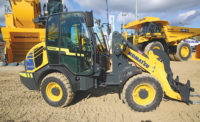When heavy equipment operator Rhonda Lepori revs up the LX01 wheel loader to transport green waste around the landfill, she has to be careful to not sneak up on other workers. “It’s a quick machine, but it’s quiet, so you have to watch out because other people don’t really hear you coming,” she says.
The LX01 is Volvo Construction Equipment’s prototype electric-hybrid wheel loader. It underwent real-world testing at Waste Management’s Redwood Landfill in Novato, Calif., for three months last winter, handling biodegradable yard waste as part of a composting operation. Running off a bank of onboard lithium-ion batteries with a 3.6-liter diesel engine recharging them as needed, the LX01 is the first prototype from Volvo CE’s ambitious Electromobility initiative.
Seeking to build on battery technology developed by its sister company Volvo Trucks, Volvo CE is trying out electric machines. “With the LX01, we have 98% new parts,” says Kent Meyers, director of advanced engineer products at Volvo CE. “We’re not looking to take this specific machine into production, but we do want to see where this road takes us.” In addition to the LX01 wheel loader, Volvo CE also is developing a prototype electric-hybrid compact excavator.
Volvo CE tested the LX01 at two WM locations in California: the Redwood landfill and a facility in Moreno Valley. The trials took place from November 2016 to May 2017 and were sponsored by the California Energy Commission and CALSTART, a clean-energy advocacy group. A report on the LX01’s performance during the trials will be presented to the energy commission in September.
“Projects like this one help California reach its ambitious climate-change goals, improve air quality and support the economy,” says John Butler, manager for alternative and renewable fuels and vehicle technology for the energy commission. “We look forward to continuing to work on innovative projects like this one and can’t wait to see machines like the LX01 deployed around California.
While the final results from the trials are not yet in, earlier testing saw fuel savings of up to 50%. “We have maybe 20% idle time on one of our big machines that runs 7.5 to 9 gallons an hour, all day,” says John Meese, senior director for heavy equipment with WM. “This thing runs for a couple of hours and burns 4.5 gallons an hour while it recharges everything. The difference in fuel alone for what it does is dramatic.”
By shifting to an electric drive, Volvo CE engineers could change up the typical wheel loader design. Each wheel is controlled by an electric motor and there are no axles, allowing the hydraulic linkage to be brought in closer for greater lift capacity. The absence of a large diesel engine or bulky emissions controls in the rear also let designers put in a steeply sloped hood, improving the operator’s sight lines in the back. “Visibility is huge for me,” says Lepori. “I’m working around people on the ground all the time."
During the trials, the LX01 recharged each evening at a custom 600V charging station, and only engaged the diesel generator during the day as needed. By decoupling the drivetrain and hydraulics from the engine, technicians were able to fine-tune performance through software to suit the individual operator’s style.
WM’s Meese sees other benefits from the dramatic redesign. “Tires are a big expense,” he notes, saying that programmable torque allows operators to reduce wheel slippage, the main cause of tire damage at WM’s sites. “There’s very little for material to wrap up in because nothing on the undercarriage is exposed. We might pay more up front, but we’ll make it back over the lifetime,” he says.






Post a comment to this article
Report Abusive Comment